Our friend Gregory M. Smith is a solitaire genius and has done many of these solo, narrative driven wargames that we have all enjoyed for hours on end while we have been unable to find an opponent or just because we want to play a game on our timeline. We have interviewed him many times for his games such as Zeppelin Raider, Interceptor Ace, The Hunted, Western Front Ace, Amerika Bomber, Defending America and most recently American Tank Ace. Greg always has something cooking in his game design kitchen and while at WBC this summer we became aware of his newest project British Tank Ace: 1940-1945, which takes a look at British tank combat during World War II and is currently up for pre-order on Compass Games website. I reached out to Greg and he was more than willing to talk with me about this new game.
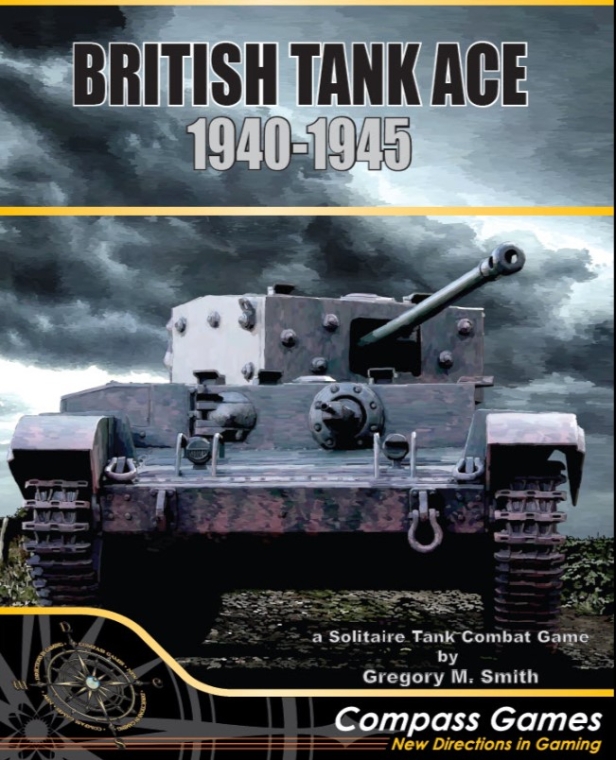
Grant: What is your new game called British Tank Ace: 1940-1945 about?
Greg: British Tank Ace: 1940-1945 is the sequel game to the Charles S. Roberts-nominated American Tank Ace: 1944-1945. I was going to do the game anyway before I knew that, but that just sealed the deal. American Tank Ace was pretty well-received and I was very happy with that, but there’s always room to improve. British Tank Ace is a solitaire, tactical-level game that puts the player in command of a British tank during World War II in North Africa, Italy, and the European Theaters of Operation. The players will make the tactical decisions a tank commander faces and control the actions of your crew while trying to survive.
Grant: What new challenges did you have to overcome with this design?
Greg: The main issue was figuring out the impact of slow vehicles (and fast vehicles.) Unlike American Tank Ace, where everything was basically a Sherman, here was had a lot of “Infantry” tanks (translation: slow as hell) on one end of the spectrum, and some really fast tanks (like the M3 Stuart) at the other end. So, because of the semi-abstracted movement effects in the game, I had to figure out the game impacts of those.
Grant: What inspired you to do this design?
Greg: I guess you could say I’ve always been a bit of an Anglophile, but after the success of American Tank Ace it just seemed like the logical follow-up to that effort and something that would be fun and interesting to explore.
Grant: What Theater of War during World War II does it occur in and what is the time frame?
Greg: This actually brings up one of the main changes from American Tank Ace as in British Tank Ace, you can play in North Africa, Italy, or the ETO (France+) and the time period of the game runs from 1940 to 1945. There is a lot of content in this game to cover that 5 year period as compared to its predecessor.
Grant: What British tank doctrine guided your design choices and efforts?
Greg: This wasn’t a big impact, as the “spreading out” of tanks (hence the “Infantry” tanks) in support had already come to an end with Dunkirk, for the most part. In the deserts of North Africa, large scale armor operations were becoming the norm. But, to be really honest, at the scale of the game (extreme tactical – you command only one tank) it really didn’t come into play much.
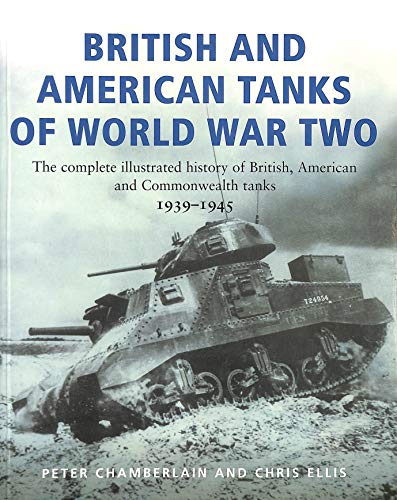
Grant: What sources did you consult about the tanks and tank warfare during WWII?
Greg: Well, probably the “Bible” for this game was British and American Tanks of World War Two by Peter Chamberlain and Chris Ellis. Superb reference and covers the American Lend-Lease Shermans (and what the British ended up naming them.) Invaluable! Of course, I also referenced Sherman and Stuart by Hunnicutt and The Encyclopedia of German Tanks of World War Two by Chamberlain, Doyle and Jentz. Information for the Italians came from a variety of sources.
Grant: What different type of tanks are available to the player?
Greg: There are 22 different tanks (and an Optional Flamethrower Churchill known as the “Crocodile.”). They are split into about even numbers between the North Africa set and the European set.
Grant: What type of research did you do to craft and quantify the specs and performance for these tanks?
Greg: The tanks really came about from a lot of research, mainly from Hunnicutt for the Lend-Lease stuff, and from the other sources listed above. Since several of the Shermans were identical to vehicles used in American Tank Ace, those became the “baseline” for values used in British Tank Ace. It make sense, and it worked.
Grant: What tanks are your personal favorites and why?
Greg: I like the Crusader II and the M3 Grant in the desert, and of course, who doesn’t like the Firefly? I like the Crusader as it’s a fun early tank, and the M3 Grant is such a beast with the 75mm -and – the 37mm gun. Although the M3 Grant is totally outclassed by the time Italy and D-Day roll around, for a while it was pretty awesome in the desert. Additionally, there’s just not a lot of games where you get a chance to play them. So, I liked that and included them. Finally, it’s hard to argue with the Firefly’s firepower.
Grant: Can you share a few of the Tank Display Mats with us and discuss the benefits and weaknesses of each?
Greg: Sure. Here’s the Crusader II Mat, with the ubiquitous 2-pounder gun. It had decent armor (for the time) but the main gun was starting to get a little underpowered at this stage of North Africa. The fact that the 2-pounder could only fire AP rounds could be considered a weak point.
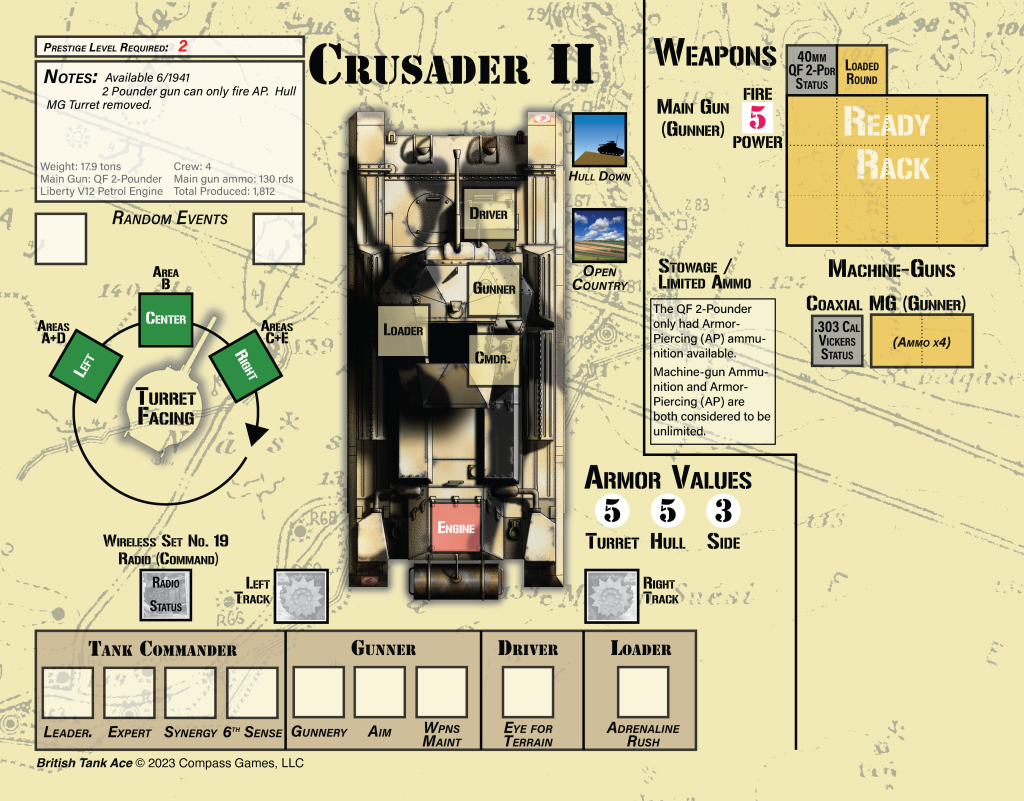
Here is also the M3 Grant Mat, basically a smorgasbord of weaponry 😊. It had excellent armor and firepower, but really, the only weak point is that the 75mm main gun was in a “sponson” with limited traverse. In the game this means it could only fire to the same area the hull is pointed at. If you become immobilized, this means you’re probably down to just using your 37mm gun.
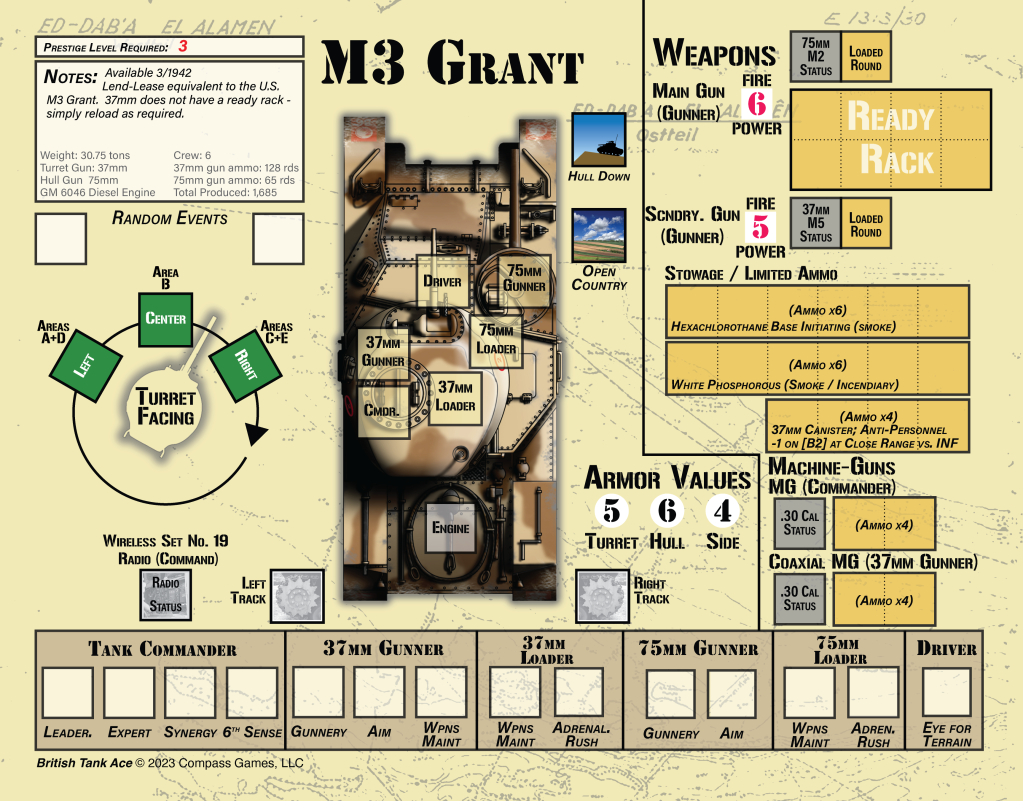
Grant: What are the different crew found in these tanks?
Greg: Obviously, that depended on the tank, but most were the standard 5-man crews including Commander, Gunner, Loader, Driver, and Bow (or Hull) Machine Gunner. You, of course, are playing as the Commander.
Grant: I know the narrative is focused on the crew with skills and awards. Any new skills added to the game?
Greg: There are not any new skills – the skills are mostly identical to American Tank Ace. I suppose I could have added “Expert Tea Brewer” or something like that, but seriously, it made good sense to leave that part of the game engine alone. There are 4 different “Expert” skills now though, that apply to different “families” of tanks (Infantry Tanks, Cruiser Tanks, Lend-Lease Tanks, and Cromwell family.). So technically those are new.
Grant: What are the available awards for crew? What is the most difficult to earn?
Greg: There are a full set of British awards, from being “Mentioned in Despatches” all the way up to the Victoria Cross. There are also a couple of NCO-only awards, and they are also included on the Officer Status Mat as a player could theoretically start as an NCO, earn them, then receive a battlefield promotion. The Victoria Cross is arguably the most difficult to earn in the game, as you have to destroy six vehicles and/or antitank guns in a single battle, and be wounded.
Grant: What role does Tank School play? What choices do players have at this step?
Greg: “Bovington Armoured Fighting Vehicles School” as it was called is very similar to Fort Knox in American Tank Ace, with the exception listed below. It is important as you can gain “coupons” to help you buy skills, such as the Gunnery Skill, or the Driving Skill, at a reduced price. Everybody attends training, but the choice comes in as to how they spend their spare time.
Grant: What is a Bar Fight? What role does it play in the prequel step?
Greg: In British Tank Ace, the “Bar Fight” has been replaced by the option of “Building Relationships.” This serves the same purpose of giving you an early Prestige Point, but its done via family social connections. It was pointed out to me that this made more sense for 1940’s British society, especially for the officers, than a bar fight. I agreed, and changed that option accordingly. But you do that, or have Extra Physical Training, or have Extra Study Time. Those are your choices.
Grant: What kind of different missions can the tank be assigned? How are these determined?
Greg: You are conducting one of four missions: Attack, Defense, Movement to Contact, or Assault. There are also two “non-missions” so to speak – Refit and No Battle. These missions are assigned by a die roll, and the results come from what theater you are currently in, combined with the timeframe.
Grant: What role does the Battle Board play in missions?
Greg: The Battle Board is where it all happens, tactically. You place your tank and array the enemy forces.
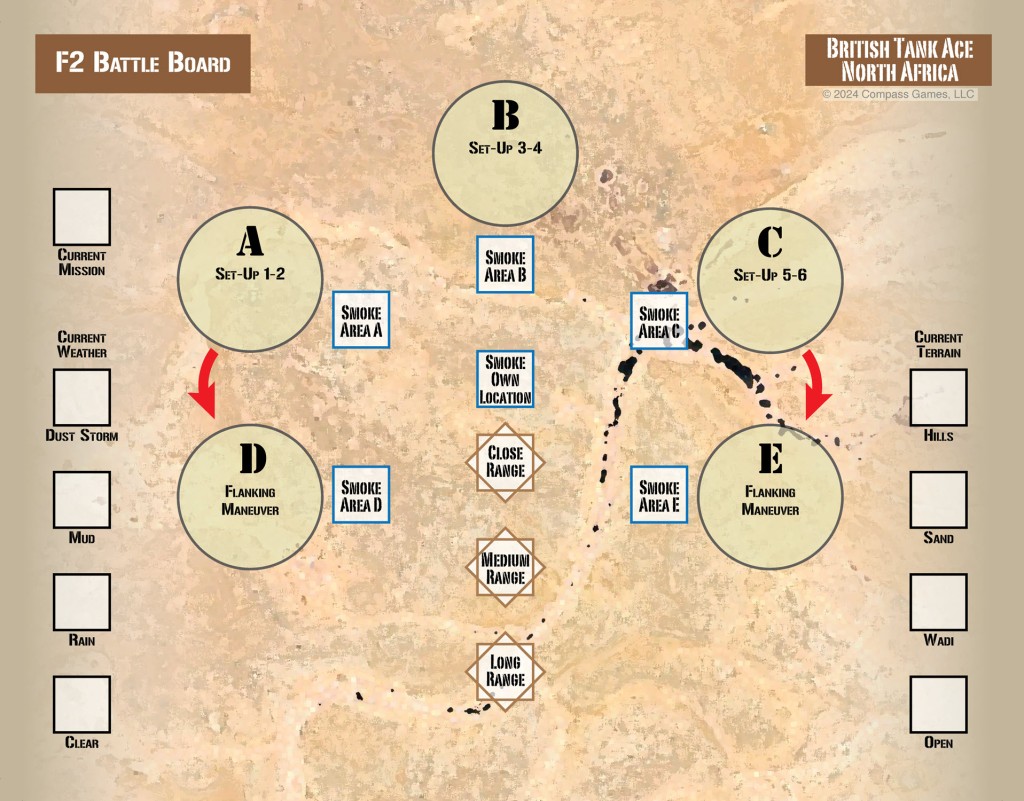
Grant: How is combat conducted?
Greg: Combat is an interesting combination of very tactical and very abstract. You have to understand you are one tank, but you are not alone. Friendly infantry and other tanks are assumed to be with you. Enemy forces do not attack you unless they randomly pick you as a target, or if you attack them first. The implication here is, don’t poke the bear unless you’re ready to fight the bear 😊. If not engaging you, they are assumed to be fighting your notional friendly forces. At the end of each round, an End of Round check determines some type of help from notional forces, or hindrance from notional enemies.
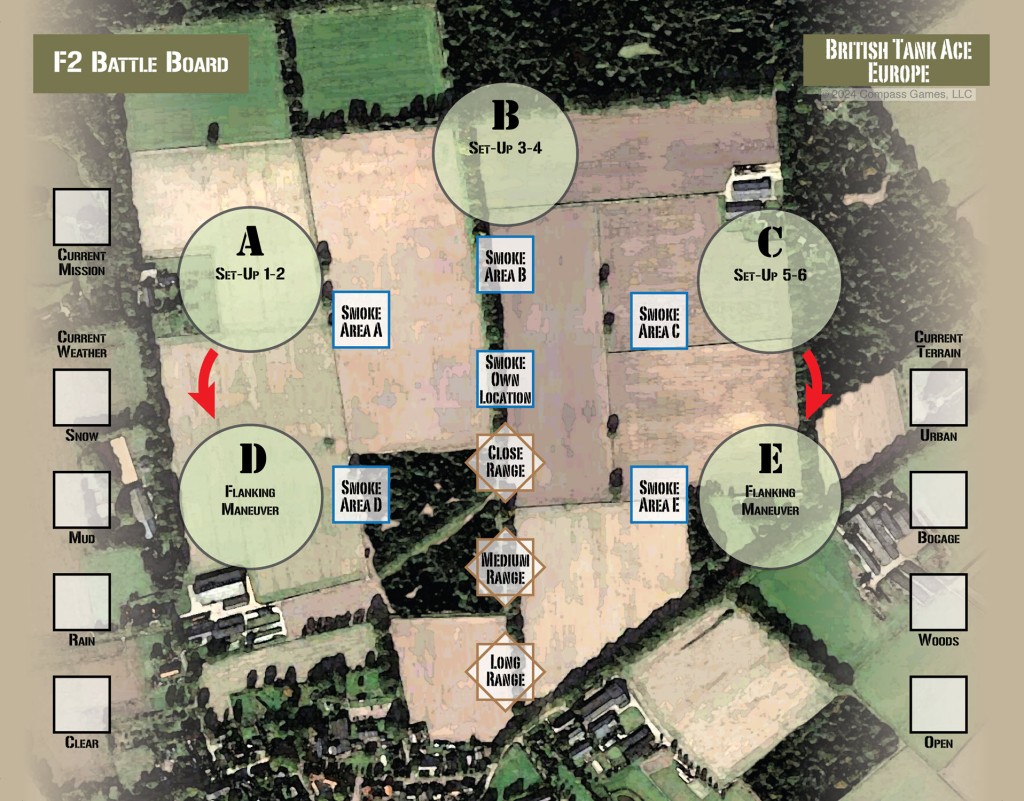
Grant: What are the various tactical decisions that players have during combat?
Greg: There’s a significant amount of decisions, from angling the hull, loading the main gun (and with what type of ammunition), turning the turret, reloading the ready rack, moving to gain hull down, moving to back up, etc. Terrain and weather also have an impact on operations, as well as smoke. Players must pay attention to hull down status, the orientation of their hull and turret, and decide when it is prudent to “button up.” Artillery and mortar fire can sometimes support either side, and random events will add to the uncertainty of combat.
Grant: What options do players have at the outset of each mission in regards to ammunition loadout?
Greg: Each Tank Mat has different loads that are available. The player gets to decide what rounds to load in the ready rack and also the one loaded in the tube before the mission starts.
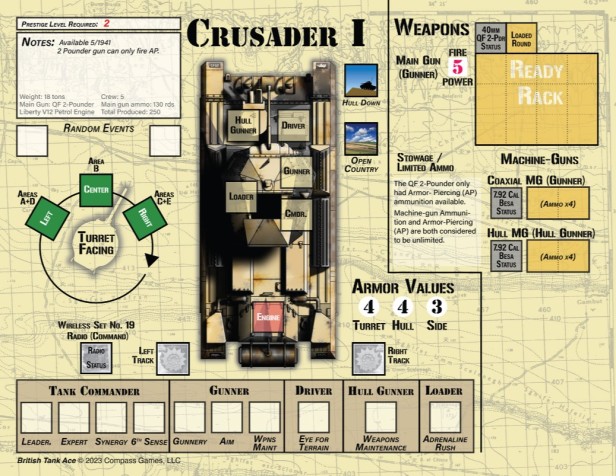
Grant: What are Major Events and how do players deal with them?
Greg: The Major Events simply tie the historical ebb and flow of the war to your tactical situation. There will be times they have no impact, but if you get to participate, you get extra experience.
Grant: How is victory determined at the end of a campaign?
Greg: There are different victory levels based on how many successful missions you have completed over the course of your career. For a Marginal Victory, you want to have at least 11 successful missions.
Grant: What was the greatest challenge in the design you had to overcome?
Greg: Probably my biggest concern was how to tie together the 3 campaigns into one large game (if desired.) It is a long game if play from 1940 to 1945. However, the use of “time jumps” when appropriate helped this out, as well as the inclusion of the “No Battle” mechanic in Italy to account for some of the time when, frankly, not much was going on there.
Grant: What changes have come about through play testing?
Greg: Not really much, we had the advantage of starting with a fairly solid game engine. Probably the two biggest changes involved artillery. It’s a little less likely to immobilize you now. Mortars now hit a random target in an area, whereas artillery hits every target in the area.
Grant: What do you feel the game design excels at?
Greg: I think it’s a neat little system that highlights the important issues of tank combat that is also playable. Too many tactical games are exceptionally tedious for not much reason (in my mind.). I think we’re reasonably historical, and technically correct, and for a game that can be played in 10-15 minutes, that’s not bad.
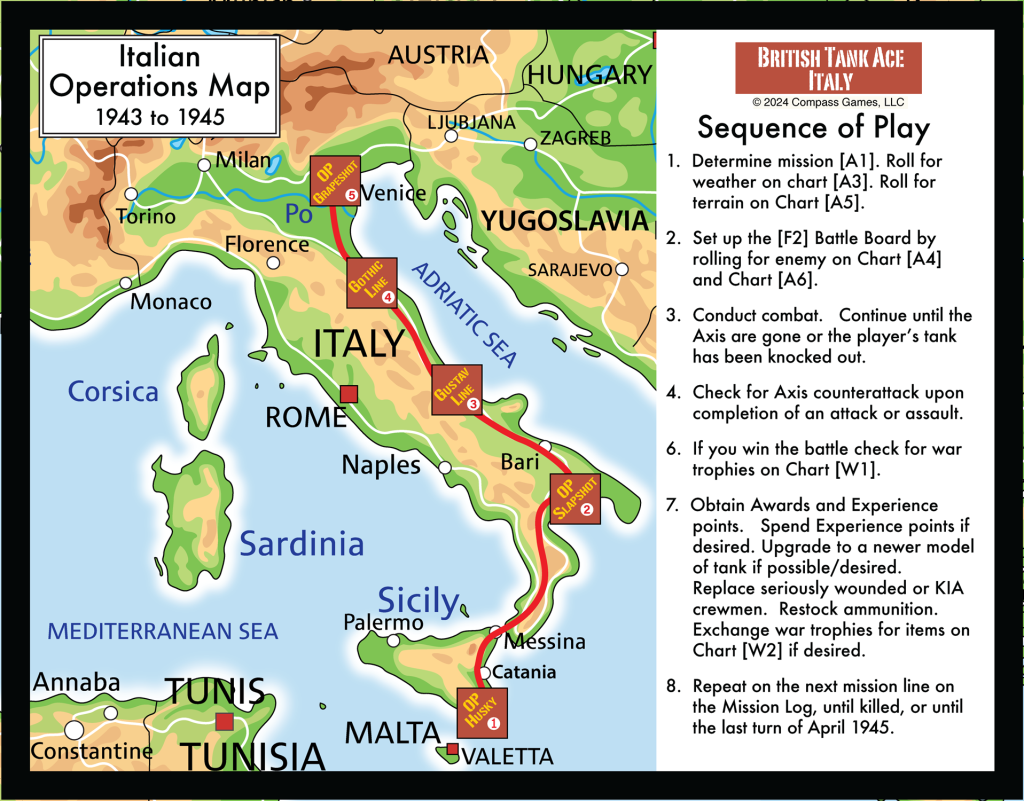
Grant: What new subjects are you contemplating for this system?
Greg: Panzer Ace and Soviet Tank Ace are well along in development. I have also started with Israeli Tank Ace, but have run into some conceptual issues which hopefully I’ll solve sooner rather than later 😊. Thanks as always for your interest, and keep up the good work!
Thank you Greg for your time and efforts with answering our many questions. We always appreciate your designs and discussing and sometimes playing them with you.
If you are interested in British Tank Ace: Europe, 1940-1945 you can pre-order a copy for $52.00 from the Compass Games website at the following link: https://www.compassgames.com/product/british-tank-ace-pay-later/
-Grant
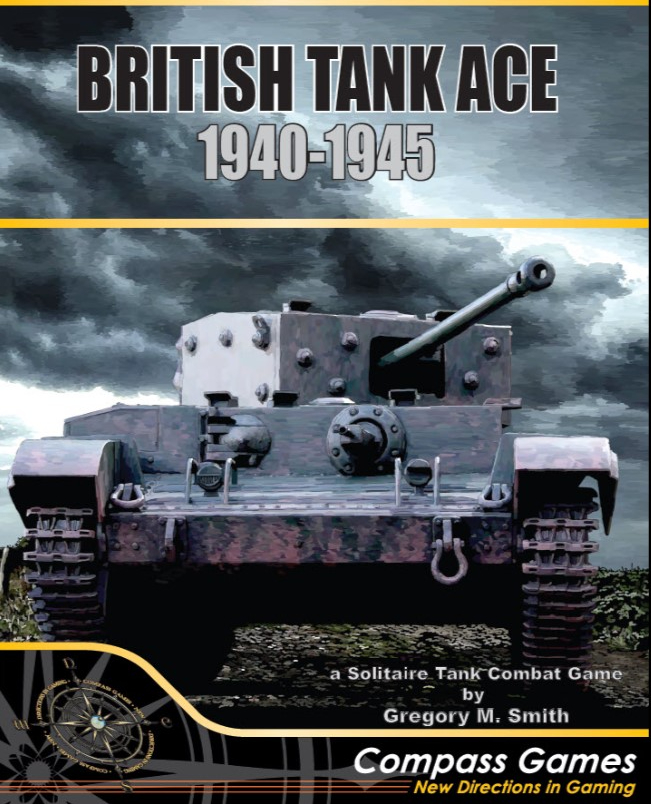
I’ve had Patton’s Best for decades. Still trying to figure out if I need to bother with American Tank Ace. Thinking I might try this one when it comes out, since it at least covers different theaters and tanks.
LikeLiked by 1 person